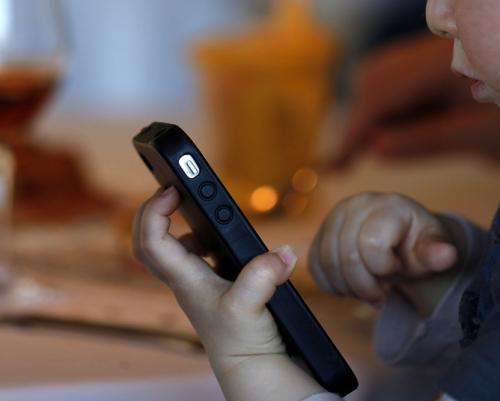Baby’s first selfie. Credit: Jenny Downing, CC BY
Tap on me, click on me, publish me! We live in an era of a digital selfie obsession. There is a growing tendency to create self-centred digital environments. You only need to look at a few Facebook profiles or the recent no make-up selfie trend to see this tendency in action.
And gradually, the selfie is creeping into digital products for young children, particularly apps and e-books. Some children's digital books allow readers to insert their own photos or narration into pre-established story templates. Many now give them the option to create their own personal stories and share them online, via Facebook or Twitter.
Selfies are not necessarily a bad thing but there are implications in letting toddlers make them part of their reading. That includes the safety issues that arise when children take pictures of themselves and the marketing implications of personalisation features.
It is crucial that adults educate and protect children from unwanted commercial influences but also the potential developmental impact that could come from selfie propagation. Children will clearly be more drawn to products which feature them as princesses or knights rather than unknown characters, but this may lead to solitary engagement and self-centredness if not supported by effective story sharing mechanisms.
While adults often take selfies with an agenda in mind, young children do so as part of their self-centred view of the world. Children under the age of three or four typically don't have fully developed theory of mind and might not be able to understand or predict what others think. Adults therefore need to be there to discuss with children what the various characters might feel or think and enrich children's personal stories with their own personal stories.
In addition, adults can help children personalise their stories, not just with pictures but also with their own texts and audio-sounds. This process can be mutually engaging as parents too, will be more motivated to share a story with their child if it contains their own voice-overs or story extensions.
Personal stories shared between parents and children at home contribute to a happy atmosphere. Personal stories shared and co-created between young children in pre-schools led to more joint problem-solving and productive talk in the classroom. Children discussed, for example, which picture to use to best represent their recent school trip or how to write a friend's name to accompany a specific picture. Similarly in special needs schools, children have been seen to be meaningfully engaged when they could verify their story understandings with others.
So if we are going to let children personalise their reading experiences, it should be about more than just let them take their own pictures. We need to support them with sharing and enriching their selfies and guide them to understand that stories should show diversity, invite co-reading and the exchange of ideas.
Source: The Conversation
This story is published courtesy of The Conversation (under Creative Commons-Attribution/No derivatives).
![]()























